Marketing for SaaS takes more than a content marketing strategy, promotions aimed at your target audience, and advertising. And it goes beyond MQLs (marketing-qualified leads) and SQLs (sales-qualified leads). Because in SaaS, not only must you attract and convert new prospects, you must retain and upsell existing users.
That said, a SaaS marketing plan doesn’t need to be complicated. It is possible to streamline your marketing efforts and drive results without having to spread yourself too thin. The key is to work efficiently and keep your focus on the right activities and metrics.
Keep reading for a revenue-first approach to B2B SaaS marketing that works especially well for small to medium-sized SaaS business, including SaaS marketing strategy and marketing throughout the customer journey.
The SaaS Business Model
One of the things that sets SaaS marketing apart is the SaaS business model itself. You aren’t just selling a product. You’re selling an experience. And you must sell it again every renewal period, whether that’s once a month or once a year.
In many ways, SaaS simplifies the user experience. The app is hosted by the SaaS company, so there’s no need to download or install the product. Users only need to have access to be able to log in and begin exploring its features.

It’s the subscription model that makes SaaS unique. With SaaS, the sale isn’t the end of the transaction. Every month or year, the customer must actively choose you again when they subscribe for another term. So not only are you marketing to prospects, you must continue marketing to customers.
Selling the Experience: Freemium vs. Trial vs. Demo
The key to SaaS marketing and sales is to give users an inside peek at what the app will do. For low-touch SaaS products, this is often done through a freemium offer.
This allows users to create an account and use the product indefinitely without paying for it. The free plan may have limited features compared to premium packages, but if the user is satisfied with their experience, they may never become a paying customer.
A good example of this is Grammarly.

Grammarly is an AI editing tool that reviews your writing and highlights typos, grammatical errors, and areas of improvement. Using its recommendations, even an untrained writer can turn out clean, clear writing. Best of all, it’s free, as long as you only need the writing editor and 100 AI prompts.
The trouble is, many users are content with the freemium features. They may be loyal users who never upgrade to a paid plan.
In cases like this, you have a few options for driving revenue. You must continue to attract and sell to new users. You must also engage free users and sell them on the value of upgrading to a paid subscription. And if all else fails, you can offer a service on the back end, as Grammarly does with their editing services.
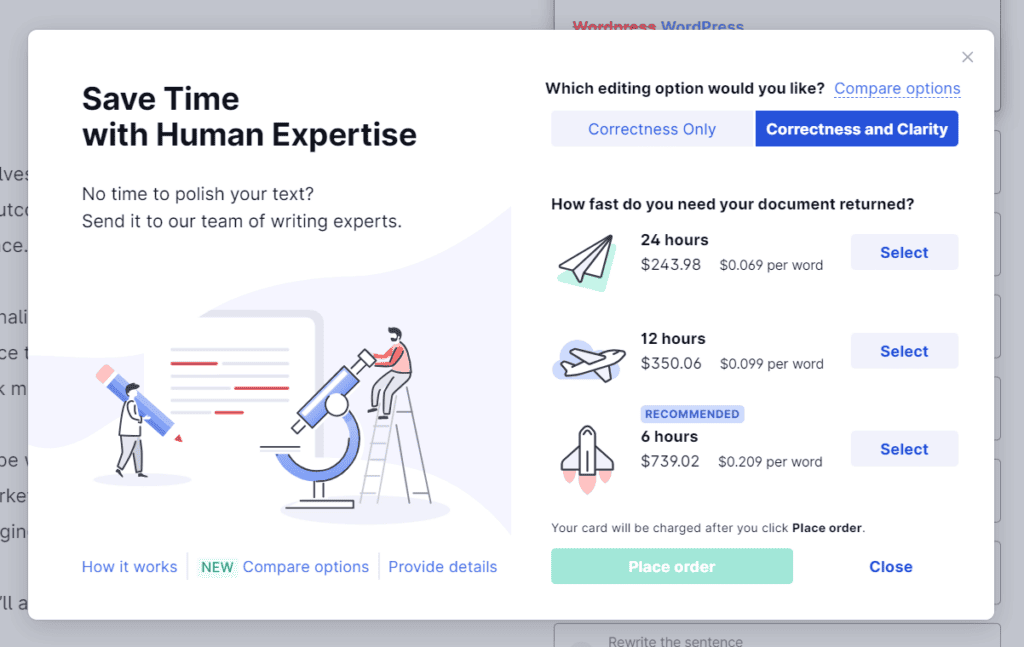
For low-touch, low-cost SaaS products, the freemium model is a proven strategy for getting users and finding product-market fit. It gives people a chance to try your app, play with its features, and test its limits. But becoming their go-to resource doesn’t guarantee a paying customer. You must trust those individuals to become so loyal, they recommend your product to business and enterprise accounts with deeper pockets.
Of course, the freemium model isn’t your only option. Take Hootsuite, for instance. They moved from a freemium model to a free trial, giving users 30 days to explore the app before their paid subscription begins.
The trial experience gives you a chance to show off your app’s benefits, but you still have to sell users on the value of a paid subscription. And you’ve got the length of your trial period to persuade users to complete the transaction.
You can get creative here. Hootsuite incents quick action by offering a 20% discount to users who skip the trial period.
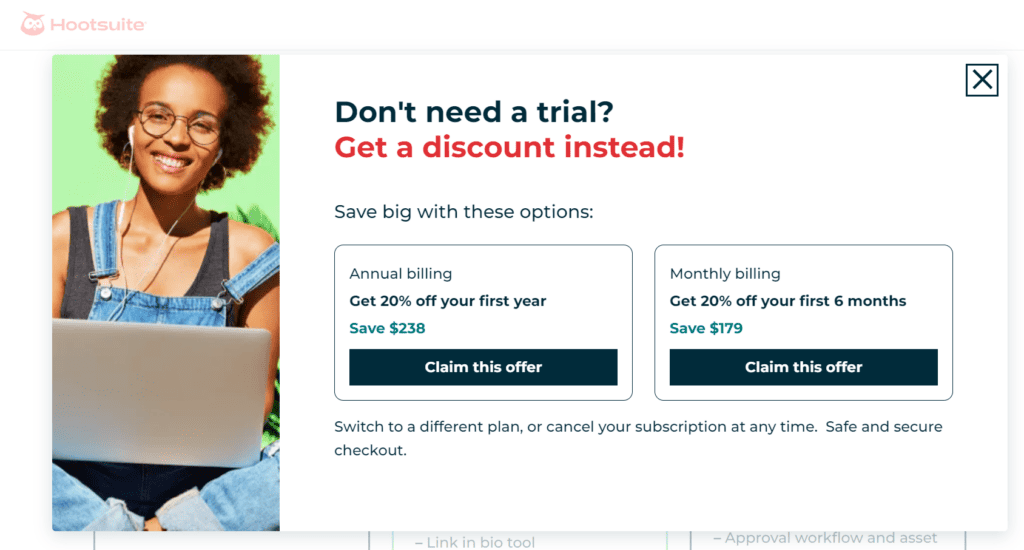
High-touch and enterprise-level apps have a similar challenge. Their product rarely has a freemium option. It would be too expensive to install and/or configure the app, only to have the customer decide it isn’t for them.
With larger SaaS products, prospective customers meet with an account manager, who gets to know their needs and expected outcomes. Rather than giving prospects access to the product, they provide demos to show off the product’s interface and features.
Revenue: The Bottom Line
Regardless of whether you offer free access, a trial period, or demos, the only way to drive SaaS profits is to sell paid subscriptions. We’ve talked about ways to get new users into the app. What we haven’t talked about is where revenue comes from.
In SaaS, you must take users on a journey. You design this journey to fit your product and whether users can access it in advance or only after they commit. But once they’re in, the journey isn’t over.
Because SaaS is a subscription model, you must maintain a relationship with your customers. You’ve got to support them, answer their questions, and help them achieve their goals with your product. You also need to maintain the app, so it stays relevant and continues to serve their needs.
This is key, because profits depend on keeping your customers long-term. We talk about the lifetime value of customers — and nowhere does this matter more than in SaaS. To grow your revenue, you need to acquire new users, activate them, and retain them.
If a customer doesn’t subscribe to a paid plan, they cost you money without returning any revenue. If a paying customer leaves, you lose that monthly revenue and lower their lifetime value. On the other hand, if you can turn customers into loyal fans, you can potentially upgrade them to higher-level plans, increasing your recurring revenue and their lifetime value.
SaaS revenue comes from four areas:
- Sales (acquisition of new users / logos)
- Retention (recurring revenue over many months or years)
- Upgrades and add-ons
- Referrals
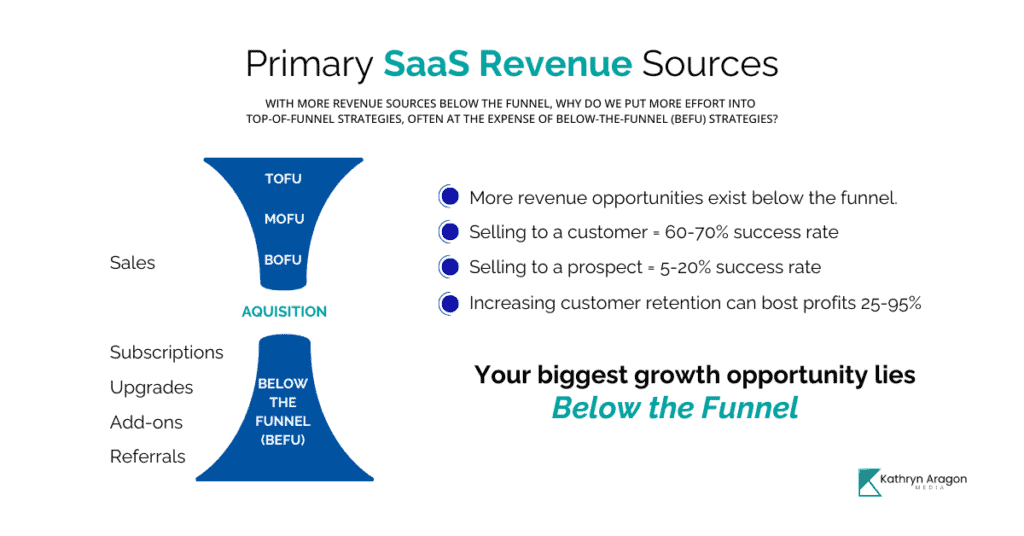
Notice that three of the four depend on existing customers. Yes, you need new customers. Yes, you need to be driving leads and sales. Be careful, though, not to limit your marketing to first-time users. It’s less expensive and easier to sell to existing users.
As we look more deeply at what it takes to market a SaaS product, remember that marketing must extend across the entire customer journey. Once you build an effective acquisition funnel, it’s critical that you continue marketing to your customers — so they stay engaged and your product becomes deeply embedded in their day-to-day.
B2B SaaS Customer Journey
In general, your customer journey follows a predictable path:
- Discovery
- Exploration
- Evaluation
- Decision
- Activation
- Loyalty
But it’s not as straightforward as you might think. People enter the journey at different stages, through different doorways, and for different reasons. You can’t control that, which means you have to map a path for your customers that’s flexible enough to adapt to each unique variation.
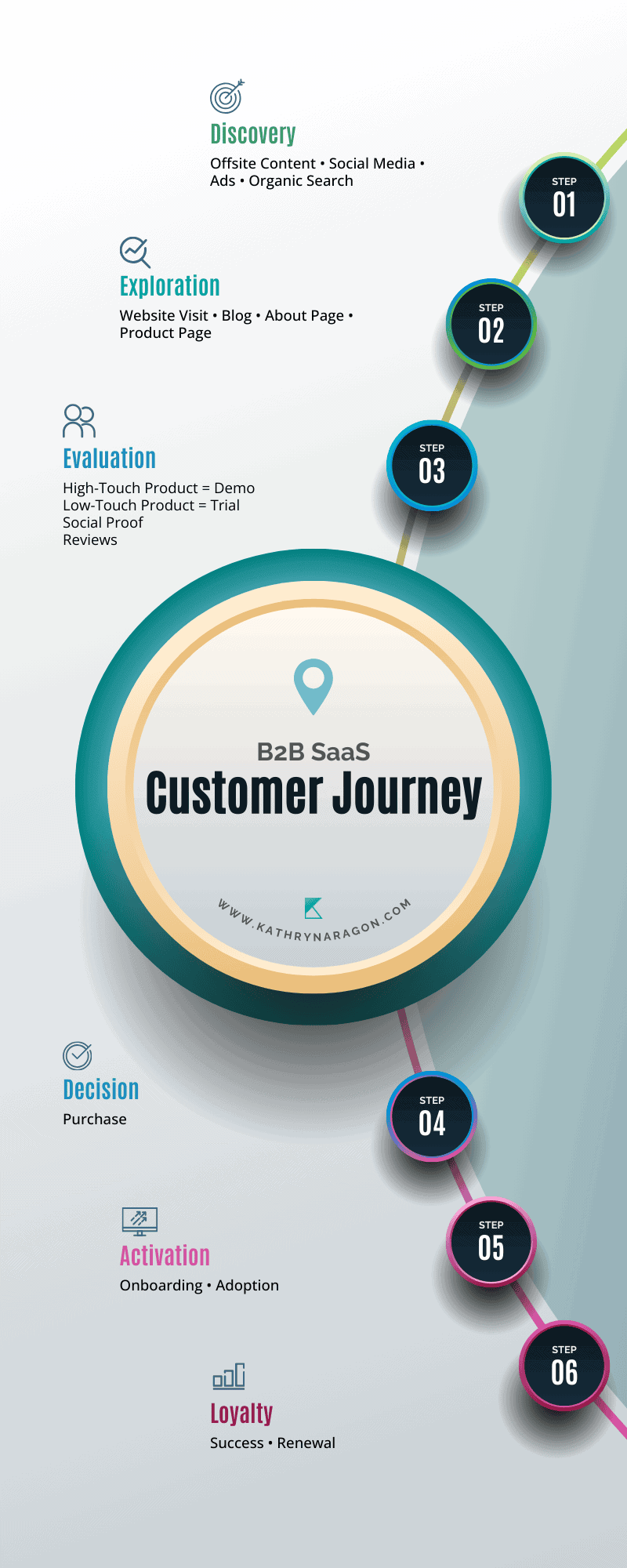
Another thing to keep in mind is the degree to which your customers need help when reviewing and purchasing your product. A low-touch SaaS product has a different customer journey than high-touch SaaSs. The funnel will look different, and you’ll architect a different type of customer experience.
A low-touch SaaS customer journey might look like this:
- Discovery / Awareness
- Engagement
- Evaluation
- Trial / Onboarding
- Product Adoption
- Upgrade / Purchase
- Product Renewal
While a high-touch SaaS customer journey might look like this:
- Discovery / Awareness
- Engagement
- Demo / Evaluation
- Purchase / Onboarding
- Product Adoption
- Account Growth / Advocacy
- Product Renewal
To design your customer journey, you’ll need to evaluate the path people take when buying your product. Not the path you think they should take. The path or paths they actually take.
Take note of the different ways they discover you and the content that prompts them to engage. Look at the information they consume before purchasing. These are clues that will help you understand your customer journey — and optimize the experience.
SaaS Marketing Strategy
Once you understand how buyers are evaluating and choosing your product, you can design a marketing strategy that fits that journey.
But SaaS companies shouldn’t jump into random acts of marketing. Your marketing team needs to develop a marketing strategy that’s appropriate for the stage of your business.

An early-stage SaaS business is focused on one thing: product-market fit. Growth at this stage means figuring out who your ideal customer is, where they are, and how you can generate demand. And because the marketing budget is usually tight, your marketing needs to be efficient.
Stage 1 Strategy: Product-Market Fit
Product-market fit occurs when you develop a product that solves a painful problem for a defined market in a way that makes them love your product.
The Product-Market Fit Pyramid was developed by Dan Olsen in his book, The Lean Product Playbook.
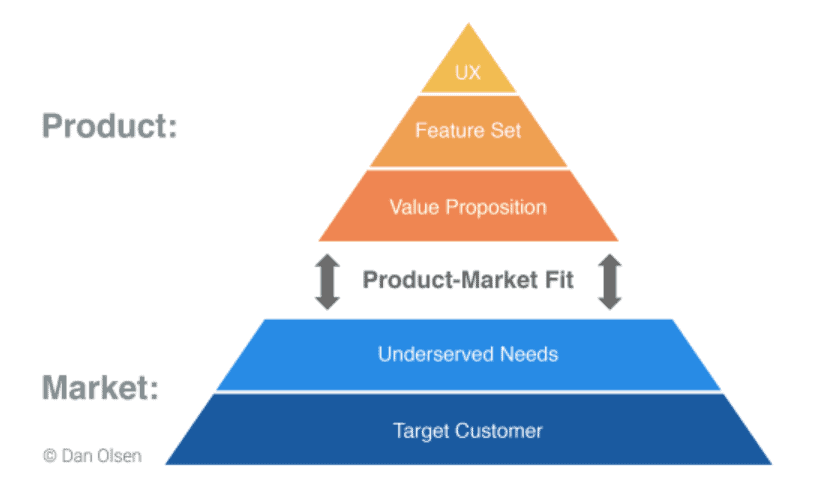
At this stage, your marketing strategy is focused on finding your market and understanding the features and outcomes that make them fall in love with your product.
You’ll use a go-to-market approach to generate demand. Start with product marketing, which will help you achieve product-market fit. As you home in on your ideal customer profile (ICP), you can adopt demand generation strategies. The goal here is to begin lowering your customer acquisition costs (CAC) to zero, or as close to it as possible.
This can be done by building an engaged audience and engaging with them through organic marketing channels: social media, podcast, YouTube, etc.
While you can also do search engine optimization (SEO) to drive organic traffic, I recommend waiting until you’ve found your ICP. SEO is a long-term strategy that takes a lot of time. It’s best to know who you’re talking to and the topics they care about. That can be done effectively on social media.
Stage 2 Strategy: Scale
Once you’ve found product-market fit, you’re ready to scale. The drivers you need to focus on are:
- Continue attracting loyal customers
- Reduce churn by making your product an essential part of their lives
- Increase customer lifetime value by upselling and retaining customers longer
At this stage, you’ll use product-led marketing, but you’ll market to people across the entire customer journey. This includes customer marketing after the sale. SaaS is a subscription, so you need to continue marketing for the lifetime of the user.
In particular, you need marketing targeted to people at the top of funnel (TOFU), bottom of funnel (BOFU), and below the funnel (BEFU).
- TOFU: Product awareness, interest
- BOFU: Solution aware
- BEFU: Feature aware
You must position your product as an elegant solution to a real problem. Once users are onboarded, you must give them instant success. Then, ongoing, you need to teach them how to get the most from your product.
Bottom line, your customer will continue using your product if it makes them look good. And that’s what customer marketing (below the funnel) is all about. Through onboarding and product education, you can turn casual users into super-users who are willing to pay for your best features.
Don’t make the mistake of ignoring customer marketing. Marketing-qualified or sales-qualified leads are important, but you’ll drive more revenue retaining and upgrading existing customers.
Marketing Throughout the Customer Journey
Let’s look at the marketing focus at each stage of the customer journey, the metrics that matter, and how you’ll improve them.
Product Discovery: Sell the Problem & Your Expertise
At the discovery stage, you’re selling the problems holding your customers back and your ability to fix that problem.
My mental shortcut for this phase is to focus on name recognition and credibility. But for you to be credible, you also need to emphasize the problem you solve. That’s why I mean by “selling” the problem. Your product doesn’t exist for its own sake. It was designed to solve a problem. Lean into that. Find the best way to articulate the pain, the solution, and why it’s better than any alternative.
Focus:
- The problem you solve
- The havoc it wreaks: Why it needs to be solved
- How others are trying to solve that problem
- How your product solves it
- Why your solution is superior
Metrics:
- A strong value proposition
- Your brand story, told in a compelling way
Marketing Activities:
- Market research
- Customer surveys / interviews
- Competitor research
Demand Generation: Sell the Outcome
To build demand, you need to make sure people understand the value proposition of your product. What does life look like without it? How does your product change that picture? What’s now possible that wasn’t possible before?
That’s the focus at this stage, so you’ll need to create content that paints this picture. Talk about the issues related to your product, and get your product in front of as many people in your ICP as possible. Consider both account-based marketing and free accounts to specific high-value prospects.
Focus:
- A digital marketing strategy that creates awareness of your product, the problem it solves, and how it solves it
- Differentiation of your product from other solutions / products
- Identify the words prospects use to describe your product
- Understand the biggest objections and questions prospects bring to the table
Metrics:
- Marketing Qualified Leads (MQLs)
- Sales Qualified Leads (SQLs)
- Activation and signups
- Customer Acquisition Cost (CAC)
- Customer Lifetime Value (LTV)
- Payback period (Ideally 12 months or less)
- Average deal size
- Content / channel performance
- Brand sentiment
Marketing Activities:
- Problem – Agitate – Solve content
- Thought leadership: social media and content marketing
- Account-based marketing: Free accounts to target accounts
- Events: speaking, booths
- Demos, sales conversations
Lead Generation: Sell a Very Specific Solution
While demand generation is top-of-funnel, lead generation is a middle- to bottom-of-funnel motion. A successful SaaS marketing campaign will rely on outbound and inbound marketing strategies to generate leads.
Develop a content strategy that establishes your brand as a leader in your industry. For example, you can create industry reports, guides, demos, and case studies. You can also leverage influencer marketing and other traditional marketing strategies.
Focus:
- Qualified leads, not the highest number of leads
- Giving leads a taste of the quality and value they’ll see in the app
- Strategic follow-up after the lead is generated
- Marketing automation that puts your campaigns on autopilot
Metrics:
- Cost per Lead (CPL)
- Cost per Acquisition (CPA)
- Number of MQLs and SQLs
- Percent of MQLs that become SQLs
- Percent of MQLs that convert to a sale
Marketing Activities:
- Funnels (see below)
- Lead magnets: eBook, guide, checklist, etc.
- Video training
- Demo: self-led and/or sales-led
B2B Marketing Funnel Examples:
Funnel example: Webinar Series
- Monthly webinar discussing problem (and related problems)
- Free download (ebook, checklist, etc.)
- Demo
- Purchase
Funnel example: Free trial
- Free trial download: premium features included
- Onboarding email sequence sharing strategies and tips for priority use cases
- Warning email: trial is about to end. Features you’ll be losing.
- Upgrade to paid
Lead-generating content: offsite and onsite
- Blog
- Social media
- YouTube or Podcast
- Webinars
Lead Nurturing: Sell the Trial / Demo
It’s vital that you regularly touch bases with leads. Create an effective SaaS marketing strategy that leverages several types of content: articles, video content, social media engagement, and more.
SaaS content marketing must build trust and engagement. That’s your focus. You need to find a cadence of delivery that keeps you top of mind without overwhelming their inbox. And you need to build value into every touch.
Best practices focus primarily on email marketing and personal touches through social media and phone calls. But many SaaS companies use a monthly newsletter to nurture leads.
The key is to create content that’s informational, educational, and relational. Become a consultant to your prospects. Position your SaaS platform as THE SaaS solution, but focus on helping your leads find the best solution for their situation. That may or may not be your product.
Focus:
- Building authority, trust, and desire
- Delivering enough value to create interest in the trial or demo
- Nailing the ratio of value content vs. sales content and calls to action
Metrics:
- Email open and clickthrough rates
- Subscriber numbers
- Community member numbers
- Content metrics: time on page, views, bounce rate
Marketing Activities:
- Email marketing
- Newsletter
- Community
- Educational content: blog, podcast, video, social, etc.
- Events: webinars, local events, Ask Me Anything
Click here to learn about 4 types of content that drive growth.
Onboarding & Adoption: Sell the Experience
Signing on a new user is just the beginning. Your SaaS customers need to fall in love with your product, and the only way for that to happen is to help them develop the habit of using the product.
Create an onboarding process that gives your users quick success. Help them find quick success. Then drip educational content that helps them master your SaaS platform and achieve the outcomes they’re looking for.
Focus:
- Smarter onboarding: timing and relevant content
- Giving user’s quick value and success
- Features overview
- Educational content
- Case studies showing how others are using the product
Metrics:
- Time to value (TTV)
- Customer engagement rate
- Trial-to-paid conversion rate
- Customer retention rate
- Email open and clickthrough rates
- Traffic and time-on-page metrics for key knowledge base articles
Marketing Activities:
- Strategic onboarding sequence
- Knowledge base articles and videos
- Super-user case studies
Upsell Users: Sell the Outcomes / Features
As a general rule, 10% of users will always want more value from you. These are the people who will upgrade to your premium packages and extra features. But they’ll only do that if they understand the value in them.
Once your users are onboarded and successfully using your product, you can continue to market to them. Show them your premium features, how they work, and the outcomes that are possible with them. Keep them updated on new features. And let them speak into future developments.
Focus:
- User product marketing to keep users updated on premium features and their value
- User customer marketing to increase your customer lifetime value
Metrics:
- Retention rate
- Upsell rate
- Revenue churn
- Customer lifetime value
Marketing Activities:
- Knowledge base articles and videos
- Newsletter
- Marketing campaigns designed to upsell current users and customers
Retention: Sell Success
To stay profitable, you need to raise your customer lifetime value, and you can only do that by keeping users engaged and active. Your product should help them reach their goals in a way that makes sense. And as their outcomes improve, they should have positive feelings about your brand and product.
Focus:
- Ongoing education and engagement
- Make users a success
- Provide a positive user experience
- Provide good customer support
Metrics:
- Customer churn rate
- Revenue churn rate
- Customer lifetime value
- Customer engagement
- Net Promoter Score (NPS)
Marketing Activities:
- Develop strategies for keeping customers from canceling, including discounts and one-on-one support
- Create renewal campaigns for customers that show signs of churning
- Send regular NPS surveys
A Revenue-First Approach
SaaS growth requires a heavy up-front investment. Because of that, you need to drive revenue from day one: to validate your product, to acquire and retain customers, to drive viral growth.
Too often, we focus marketing on leads and sales. But three-fourths of SaaS revenue comes from existing customers. Don’t get stuck on top-of-funnel strategies. Get those strategies in place, then focus your attention on customers.
Marketing at the bottom of the funnel and below, you can drive both revenue and growth. And it’s a natural continuation of the marketing that sold your customers, continuing to build relationships and value.
Need help driving revenue through the entire customer journey? Let’s look for low-hanging fruit at the bottom and below your marketing funnel. Schedule a call today.


